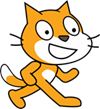
There are so many great things about Scratch: it teaches programming skills to kids, it’s fun and easy, and it’s free! Another fantastic feature is the Scratch online community. Students can browse completed projects, try tutorials, create interactive media, share, get feedback, learn from others, participate in discussion forums, and more! A bonus spinoff of this learning community is that students build essential digital citizenship skills as they interact with other Scratch programmers.
Scratch can be used offline, but there are so many benefits to joining the creative online community of Scratchers! If you are interested in digital citizenship and coding, TechnoCode has programming lessons that are the perfect fit.
Starter Projects

Scratch has an extensive gallery of sample animations, games, interactive art, music, and stories. New users are encouraged to view them, look at the basic code, and modify them. The code often has tips that explain what it does. Suggestions are given for what can be changed: add sprites to a story, devise more obstacles for a game, or add sound effects. This is a great way for students to create their own unique project yet experience success early in their learning.
Look at the Code

The See Inside button allows you to view the programming of a project. You can see how someone else’s project works, figure out the blocks needed to create a specific effect, add part of a project to your backpack, or remix it and save it as a new project.
Tutorials
Users new to Scratch can follow step-by-step, animated tutorials to make a project. Alternatively, download a set of illustrated, colorful activity cards and print them for easy to follow instructions.
Remix
The motto of Scratch is Imagine, Program, Share. Budding programmers can learn by downloading and modifying the work of others. Check out how many remixes there are of a sample project in the gallery – sometimes there are over 100 different versions of the original!
When it is uploaded, the remix of another creator’s project automatically gives credit to the original author and any others who contributed to it. Students are also encouraged to write something like “Based on […] by […]” Or “Thanks to […] for […]” In the Project Notes. Citing the source is an essential skill that students must master in any research work. Learning to acknowledge an author and avoiding plagiarism is a critical part of fostering sound digital citizenship.
Build Key Personal Skills
As young people learn to program, they learn to be innovative, build logical and computational thinking, and work collaboratively. These are all important life skills as well as fundamental competencies for the careers of the future.
Foster Digital Citizenship
Using the Scratch online community, students share their work, ask for help, exchange ideas and projects, and collaborate. As students view the work of others, they can click a star to ‘favorite a project’, click a heart to ‘love a project’, or leave a comment. This support boosts the concept of a community of creators who are working together and who encourage one another.
There’s also a set of Scratch Community Guidelines, a brief outline of common sense standards:
- Be respectful
- Be constructive
- Share
- Keep personal info private
- Be honest
- Help keep the site friendly
As students are building programming skills, Scratch can also help them to develop safe and responsible online practices.
Promote Digital Citizenship with Scratch Coding Lessons
TechnoCode, is a Scratch project with activities that emphasize digital citizenship. Lessons include instructions that guide students to share Scratch projects appropriately. Teach how to give credit to peers when remixing, cite the source of external resources, and comment responsibly. Moreover, their are many collaborative learning opportunities. Teach digital citizenship by joining the Scratch community. Lessons in TechnoCode promote responsible behavior.

